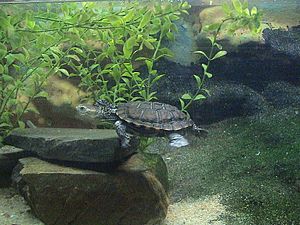Western swamp turtle facts for kids
Quick facts for kids Western swamp turtle |
|
|---|---|
 |
|
| Pseudemydura umbrina, Western swamp tortoise | |
| Conservation status | |
| Scientific classification | |
| Genus: |
Pseudemydura
|
| Species: |
umbrina
|
| Synonyms | |
|
|
The western swamp turtle (Pseudemydura umbrina) is a special freshwater turtle. People in Western Australia often call it the western swamp tortoise.
This small turtle lives in swamps near Perth, Western Australia. Sadly, its home has changed a lot. Because of this, only small groups of these turtles are left. This makes them a critically endangered species.
Contents
How Scientists Name and Classify Animals
Scientists give every animal a special name. This helps everyone know exactly which animal they are talking about. The western swamp turtle got its scientific name, Pseudemydura umbrina, in 1901. It was named by a scientist named Friedrich Siebenrock.
The first western swamp tortoise was found in 1839. It was sent to a museum in Vienna. For a long time, no more were found. Then, in 1953, more turtles were discovered. Another scientist, Ludwig Glauert, gave them a different name. But later, in 1958, a scientist from Harvard University showed that it was the same species. So, Pseudemydura umbrina is the correct name.
What Does the Western Swamp Turtle Look Like?
These turtles are quite small. Adult male turtles are usually no longer than 15.5 centimeters (about 6 inches). They weigh up to 550 grams (about 1.2 pounds). Female turtles are a bit smaller. They grow to about 13.5 centimeters (about 5.3 inches) and weigh up to 410 grams (about 0.9 pounds). Baby turtles, called hatchlings, are tiny. They are only about 2.4 to 2.9 centimeters long.
The color of these turtles can change. It depends on how old they are and where they live. Baby turtles are usually grey on top. Their bellies are bright cream and black. Adult turtles can be different shades. They might be yellow-brown in swamps with clay. In sandy swamps with dark water, they can look almost black.
Their bottom shell, called a plastron, also varies in color. It can be yellow, brown, or sometimes black. Often, it has black spots on a yellow background. The edges of their shell plates, called scutes, are often black. Their legs are short and covered in scales. They have strong claws on their feet. Their short neck has bumpy parts called tubercles. On top of their head, they have one large scale. This turtle is the smallest type of chelid turtle in Australia.
Where Do Western Swamp Turtles Live?
The western swamp turtle only lives in a few places. These places are on the Swan Coastal Plain in Western Australia. This area stretches from Perth Airport north towards Pearce Royal Australian Air Force Base.
Much of this land has been changed by people. It is now used for cities, farms, or for digging up clay. This means there are fewer natural swamps for the turtles to live in.
Protecting the Western Swamp Turtle
The western swamp turtle is in great danger. Both the Australian government and the government of Western Australia say it is critically endangered. This means it is at a very high risk of disappearing forever.
Scientists have made plans to help these turtles. The first plan was in 1994, and it gets updated. The newest plan is from 2010.
What Harms the Turtles?
Several things make it hard for these turtles to survive:
- Their populations are small and spread out. They live in nature reserves that are often too small for them.
- Red foxes, which were brought to Australia, hunt the turtles.
- The way water flows in their swamps has changed. This is because of how people use the land and take water from underground.
- Less rainfall due to climate change also makes their swamps drier.
How Can We Help?
People are working hard to save the western swamp turtle:
- They watch the turtle populations to see how they are doing.
- They manage the nature reserves to make them better homes for the turtles.
- They breed turtles at Perth Zoo. Then, they release these turtles back into the wild.
- A group called "The Friends of the Western Swamp Tortoise" helps teach people about the turtles. They also get people involved in helping.


